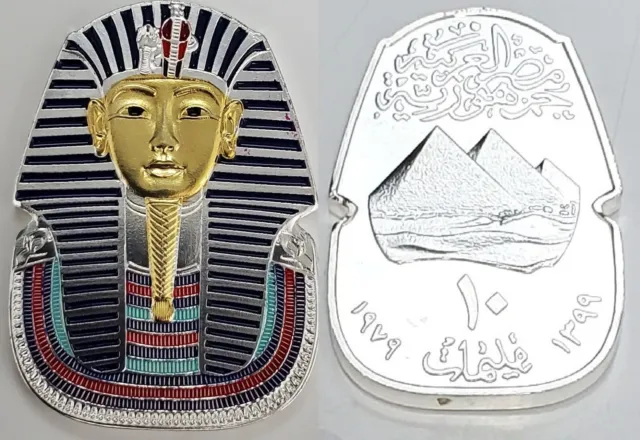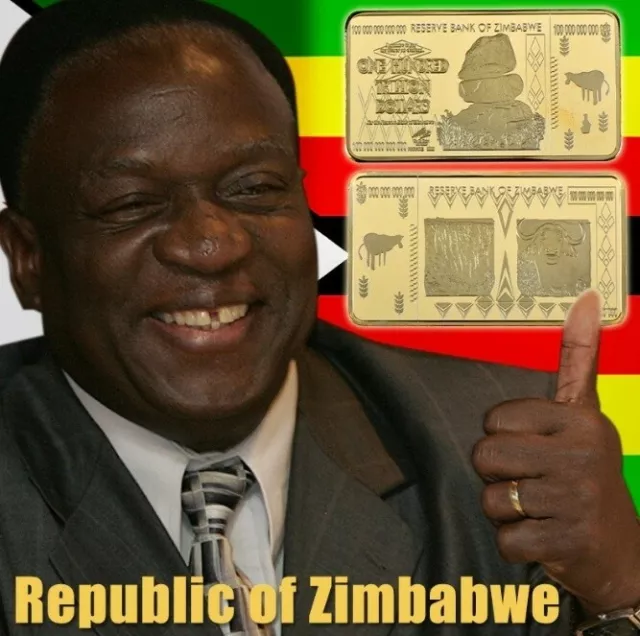Simbabwe Gold Silberbarren Banknote Geld Afrika Bargeld alte Rechnung Safari USA
| 100 Trillion Dollar Bank Note Silver & Gold Layered Bar This is a Zimbabwe 100,000,000,000 Dollar Bank Note which has been made into a Gold Layered Bar Due to Hyper inflation in the country the original 100 Trillion note was not worth a lot it isnt worth a lot Why not make yourself or someone else a trillionaire? Would make an Excellent Stocking Filler at Christmas! Dimension 43mm x 30mm x 3mm Weights 1 oz Gold & Silver Layered Overseas Bidders Please Note Surface Mail Delivery Times > Western Europe takes up to 2 weeks, Eastern Europe up to 5 weeks, North America up to 6 weeks, South America, Africa and Asia up to 8 weeks and Australasia up to 12 weeks For that Interesting Conversational Piece, A Birthday Present, Christmas Gift, A Comical Item to Cheer Someone Up or That Unique Perfect Gift for the Person Who has Everything....You Know Where to Look for a Bargain! XXXX - DO NOT CLICK HERE - XXXX Click Here to Add me to Your List of Favourite Sellers If You Have any Questions Please Message me through ebay and I Will Reply ASAP Thanks for Looking and Best of Luck with the Bidding!! I have sold items to coutries such as Afghanistan * Albania * Algeria * American Samoa (US) * Andorra * Angola * Anguilla (GB) * Antigua and Barbuda * Argentina * Armenia * Aruba (NL) * Australia * Austria * Azerbaijan * Bahamas * Bahrain * Bangladesh * Barbados * Belarus * Belgium * Belize * Benin * Bermuda (GB) * Bhutan * Bolivia * Bonaire (NL) * Bosnia and Herzegovina * Botswana * Bouvet Island (NO) * Brazil * British Indian Ocean Territory (GB) * British Virgin Islands (GB) * Brunei * Bulgaria * Burkina Faso * Burundi * Cambodia * Cameroon * Canada * Cape Verde * Cayman Islands (GB) * Central African Republic * Chad * Chile * China * Christmas Island (AU) * Cocos Islands (AU) * Colombia * Comoros * Congo * Democratic Republic of the Congo * Cook Islands (NZ) * Coral Sea Islands Territory (AU) * Costa Rica * Croatia * Cuba * Curaçao (NL) * Cyprus * Czech Republic * Denmark * Djibouti * Dominica * Dominican Republic * East Timor * Ecuador * Egypt * El Salvador * Equatorial Guinea * Eritrea * Estonia * Ethiopia * Falkland Islands (GB) * Faroe Islands (DK) * Fiji Islands * Finland * France * French Guiana (FR) * French Polynesia (FR) * French Southern Lands (FR) * Gabon * Gambia * Georgia * Germany * Ghana * Gibraltar (GB) * Greece * Greenland (DK) * Grenada * Guadeloupe (FR) * Guam (US) * Guatemala * Guernsey (GB) * Guinea * Guinea-Bissau * Guyana * Haiti * Heard and McDonald Islands (AU) * Honduras * Hong Kong (CN) * Hungary * Iceland * India * Indonesia * Iran * Iraq * Ireland * Isle of Man (GB) * Israel * Italy * Ivory Coast * Jamaica * Jan Mayen (NO) * Japan * Jersey (GB) * Jordan * Kazakhstan * Kenya * Kiribati * Kosovo * Kuwait * Kyrgyzstan * Laos * Latvia * Lebanon * Lesotho * Liberia * Libya * Liechtenstein * Lithuania * Luxembourg * Macau (CN) * Macedonia * Madagascar * Malawi * Malaysia * Maldives * Mali * Malta * Marshall Islands * Martinique (FR) * Mauritania * Mauritius * Mayotte (FR) * Mexico * Micronesia * Moldova * Monaco * Mongolia * Montenegro * Montserrat (GB) * Morocco * Mozambique * Myanmar * Namibia * Nauru * Navassa (US) * Nepal * Netherlands * New Caledonia (FR) * New Zealand * Nicaragua * Niger * Nigeria * Niue (NZ) * Norfolk Island (AU) * North Korea * Northern Cyprus * Northern Mariana Islands (US) * Norway * Oman * Pakistan * Palau * Palestinian Authority * Panama * Papua New Guinea * Paraguay * Peru * Philippines * Pitcairn Island (GB) * Poland * Portugal * Puerto Rico (US) * Qatar * Reunion (FR) * Romania * Russia * Rwanda * Saba (NL) * Saint Barthelemy (FR) * Saint Helena (GB) * Saint Kitts and Nevis * Saint Lucia * Saint Martin (FR) * Saint Pierre and Miquelon (FR) * Saint Vincent and the Grenadines * Samoa * San Marino * Sao Tome and Principe * Saudi Arabia * Senegal * Serbia * Seychelles * Sierra Leone * Singapore * Sint Eustatius (NL) * Sint Maarten (NL) * Slovakia * Slovenia * Solomon Islands * Somalia * South Africa * South Georgia (GB) * South Korea * South Sudan * Spain * Sri Lanka * Sudan * Suriname * Svalbard (NO) * Swaziland * Sweden * Switzerland * Syria * Taiwan * Tajikistan * Tanzania * Thailand * Togo * Tokelau (NZ) * Tonga * Trinidad and Tobago * Tunisia * Turkey * Turkmenistan * Turks and Caicos Islands (GB) * Tuvalu * U.S. Minor Pacific Islands (US) * U.S. Virgin Islands (US) * Uganda * Ukraine * United Arab Emirates * United Kingdom * United States * Uruguay * Uzbekistan * Vanuatu * Vatican City * Venezuela * Vietnam * Wallis and Futuna (FR) * Yemen * Zambia * Zimbabwe and major cities such as Tokyo, Yokohama, New York City, Sao Paulo, Seoul, Mexico City, Osaka, Kobe, Kyoto, Manila, Mumbai, Delhi, Jakarta, Lagos, Kolkata, Cairo, Los Angeles, Buenos Aires, Rio de Janeiro, Moscow, Shanghai, Karachi, Paris, Istanbul, Nagoya, Beijing, Chicago, London, Shenzhen, Essen, Düsseldorf, Tehran, Bogota, Lima, Bangkok, Johannesburg, East Rand, Chennai, Taipei, Baghdad, Santiago, Bangalore, Hyderabad, St Petersburg, Philadelphia, Lahore, Kinshasa, Miami, Ho Chi Minh City, Madrid, Tianjin, Kuala Lumpur, Toronto, Milan, Shenyang, Dallas, Fort Worth, Boston, Belo Horizonte, Khartoum, Riyadh, Singapore, Washington, Detroit, Barcelona,, Houston, Athens, Berlin, Sydney, Atlanta, Guadalajara, San Francisco, Oakland, Montreal, Monterey, Melbourne, Ankara, Recife, Phoenix/Mesa, Durban, Porto Alegre, Dalian, Jeddah, Seattle, Cape Town, San Diego, Fortaleza, Curitiba, Rome, Naples, Minneapolis, St. Paul, Tel Aviv, Birmingham, Frankfurt, Lisbon, Manchester, San Juan, Katowice, Tashkent, Fukuoka, Baku, Sumqayit, St. Louis, Baltimore, Sapporo, Tampa, St. Petersburg, Taichung, Warsaw, Denver, Cologne, Bonn, Hamburg, Dubai, Pretoria, Vancouver, Beirut, Budapest, Cleveland, Pittsburgh, Campinas, Harare, Brasilia, Kuwait, Munich, Portland, Brussels, Vienna, San Jose, Damman , Copenhagen, Brisbane, Riverside, San Bernardino, Cincinnati and Accra |
- Condition: In Excellent Condition
- Denomination: commemorative
- Year of Issue: 2020
- Number of Pieces: 1
- Collections/ Bulk Lots: No
- Time Period: 2000s
- Collection: Zimbabwe
- Fineness: Unknown
- Features: Commemorative
- Country/Region of Manufacture: Zimbabwe
- Modified Item: No
- Country of Origin: Great Britain
- Colour: Gold
PicClick Insights - Simbabwe Gold Silberbarren Banknote Geld Afrika Bargeld alte Rechnung Safari USA PicClick Exklusiv
- Popularität - 0 Beobachter, 0.0 neue Beobachter pro Tag, 2 days for sale on eBay. 0 verkauft, 1 verfügbar.
- Bestpreis -
- Verkäufer - 3.330+ artikel verkauft. 0.3% negativ bewertungen. Großer Verkäufer mit sehr gutem positivem Rückgespräch und über 50 Bewertungen.
Die Leute Mochten Auch PicClick Exklusiv

Gold Silver Pharaoh Coin Medal Egypt Pyramids History Sphinx Roman Empire Old UK
EUR 20,90 Sofort-Kaufen 10d 8h
Armstrong Moon Landing Apollo Man on the Silver Coin NASA Space U C Old USA Neil
EUR 7,02 1 Gebot 5d 10h
Fort Knox Silver & Gold Layered Bar Kentucky Mint Donald Trump Autograph Ingot
EUR 18,11 Sofort-Kaufen 26d 10h
100 Trillion Dollar Zimbabwe Gold Bar Bank Note Money African Bullion Cash Old
EUR 12,53 Sofort-Kaufen 19d 6h
1912 RMS TITANIC Silver Coin Fiji Canada Ship Ice Berg Queen Elizabeth II Old UK
EUR 13,92 Sofort-Kaufen 3d 7h


